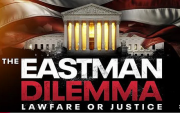Cleveland, Ohio — The premier showing of the movie Hillary’s America — The Secret History of the Democratic Party was held in Cleveland on the eve of the beginning of the Republican National Convention. The partisan crowd, eager to hear anything good about Republicans and anything bad about Democrats, gave a standing ovation at the end. Larry Gatlin and Gatlin Brothers appeared on stage after the movie, as did Dinesh D’Souza and numerous members of the cast and crew.
While parts of the movie were well-researched, the accounts of numerous other events, especially those more than 100 years in the past could have been researched more thoroughly. For example, the American Civil War was portrayed as a war over slavery, which is the current way it is taught in most schools today. Granted, every state that seceded from the Union was a slave state, and slavery in this country was abolished by the 13th Amendment, which was ratified on December 6, 1865, shortly after the war ended. But another major issue was states’ rights, a power struggle between the states and the federal government. Evidence of this can seen in that five slave states — Missouri, Kentucky, West Virginia, Maryland, and Delaware — did not secede, and they fought on the Union’s side. All that notwithstanding, as the movie indicated, it is true that ending slavery was predominantly advanced by Republicans.
Too, Lyndon Johnson’s political path was only superficially covered. While Johnson’s political flip-flop on civil rights was documented, showing how he changed from a segregationist senator from a southern state to appeal to a national audience when he ran as national candidate, such political flip-flops are not uncommon for politicians, especially career politicians of both major political parties. Yet missing from the film was any mention of the overwhelming evidence of stuffing the ballot box in the 1948 Senate Runoff Election in Texas or Ballot Box 13 or any other suspicious elections.
Likewise, the emphasis when commenting about Bill Clinton’s impeachment was placed on Clinton’s sexual exploits, not his gross handling of national security so that he could benefit himself. The Bill Clinton impeachment was covered as a sexual predator issue, yet careful research would show that the original articles of impeachment filed by Congressman Bob Barr had no mention of sexual exploitation and were about national security and improper access to the White House. Many members of The John Birch Society participated in the Impeach Clinton Now campaign, which was run as an educational campaign. Only when the Impeach Clinton Now campaign gained traction and the prospect of impeachment became a reality did the impeachment campaign get co-opted by those who preferred impeachment of the president for sexual misconduct rather than national security reasons.
The aforementioned criticisms notwithstanding, the movie made several solid points about Hillary Clinton’s affection for the beliefs of community organizer Saul Alinksy, who believed in succeeding by almost any means, including treachery. The movie also showed that many African-Americans aren’t much better off today than they were on the plantations under slavery, as they live in dependency to the federal government on “urban plantations.” The film also brought up numerous points about Clinton Foundation finances and how the United States is losing control over a portion of the production of uranium ore — likely because of foreign payoffs to the Clintons, through their foundation.
The movie portrayed the Democratic Party as villainous and the Republican Party as noble, which is largely wishful thinking, unfortunately. There isn’t any great difference between the two parties. In fact, in Bill Clinton’s presidential acceptance speech in 1992, he praised Professor Carroll Quigley. In Quigley’s book Tragedy and Hope, which was written after Quigley had been granted access to many years of documents of a group of wealthy, powerful, politically connected men, he said that the plan was to have the parties be almost indestinguishable from each other: “The two parties should be almost identical, so that the American people can ‘throw the rascals out’ at any election without leading to any profound or extensive shifts in policy.”
Isn’t that what happened with ObamaCare? The voters reacted to ObamaCare by casting their ballots to throw the rascals out who voted for ObamaCare, but now ObamaCare repeal is stalled in the Republican-controlled Senate.
Hillary’s America — The Secret History of the Democratic Party is a mixed bag. For those who focus on the short-term and want to see Hillary Clinton defeated, this movie will be very appealing. For those who want a long-term, educational movement, perhaps there will be sequel that might incorporate parts of Arthur Thompson’s latest book To the Victors Go the Myths and Monuments.




